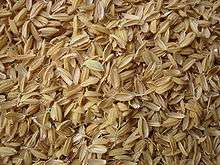Chaff

Chaff (/ˈtʃæf/ or /ˈtʃɑːf/)[1] is the dry, scaly protective casings of the seeds of cereal grain, or similar fine, dry, scaly plant material such as scaly parts of flowers, or finely chopped straw. Chaff is indigestible by humans, but livestock can eat it and in agriculture it is used as livestock fodder, or is a waste material ploughed into the soil or burnt.
Etymology
| Look up chaff or glume in Wiktionary, the free dictionary. |
"Chaff" comes from Middle English chaf, from Old English ceaf, related to Old High German cheva, "husk".
Grain chaff

In grasses (including cereals such as rice, barley, oats and wheat), the ripe seed is surrounded by thin, dry, scaly bracts (called glumes, lemmas and paleas), forming a dry husk (or hull) around the grain. Once it is removed it is often referred to as chaff.
In wild cereals and in the primitive domesticated einkorn,[2] emmer[3] and spelt[4] wheats, the husks enclose each seed tightly. Before the grain can be used, the husks must be removed.
The process of loosening the chaff from the grain so as to remove it is called threshing – traditionally done by milling or pounding. Separating remaining loose chaff from the grain is called winnowing – traditionally done by repeatedly tossing the grain up into a light wind which gradually blows the lighter chaff away. This method typically utilizes a broad, plate-shaped basket or similar receptacle to hold and collect the winnowed grain as it falls back down.
Domesticated grains such as durum wheat and common wheat have been bred to have chaff that is easily removed. These varieties are known as free-threshing or naked.
Chaff should not be confused with bran, which is finer scaly material that is part of the grain itself.
Straw chaff
Chaff is also made by chopping straw (or sometimes coarse hay) into very short lengths, using a machine called a chaff cutter. Like grain chaff this is used as animal feed, and is a way of turning coarse fodder into a form more palatable to livestock.[5][6][7]
Botany
In botany, chaff refers to the thin receptacular bracts of many species in the sunflower family Asteraceae and related families. They are modified scale-like leaves surrounding single florets in the flower-head.
Metaphor
Chaff as a waste product from grain processing leads to a metaphorical use of the term, to refer to something seen as worthless. This is commonly used in the expression "to separate the wheat from the chaff" from Matthew 3:12 which says: Whose fan is in his hand, and he will thoroughly purge his floor, and gather his wheat into the garner; but he will burn up the chaff with unquenchable fire. Compare also the "Parable of the Tares", which refers to a mixture of wheat and tares (a kind of weed). Another example is in Psalm 1:4 of the Bible, which says: The ungodly are not so: but are like the chaff which the wind driveth away. (KJV)
Use
Hungarian engineer László Schremmer has recently discovered that by the use of chaff-based filters it is possible to reduce the arsenic content of water to 3 microgram/litre. This is especially important in areas where the potable water is provided by filtering the water extracted from the underground aquifer.[8]
See also
References
- ↑ Daniel Jones (2006). Peter Roach; James Hartman; Jane Setter, eds. Cambridge Pronouncing Dictionary. Cambridge University Press.
- ↑ Potts, D. T. (1996) Mesopotamia Civilization: The Material Foundations Cornell University Press. p. 62. ISBN 0-8014-3339-8.
- ↑ Nevo, Eviatar & A. B. Korol & A. Beiles & T. Fahima. (2002) Evolution of Wild Emmer and Wheat Improvement: Population Genetics, Genetic Resources, and Genome.... Springer. p. 8. ISBN 3-540-41750-8.
- ↑ Vaughan, J. G. & P. A. Judd. (2003) The Oxford Book of Health Foods. Oxford University Press. p. 35. ISBN 0-19-850459-4.
- ↑ "The Chaff cutter"
- ↑ Cutting chaff by hand: detail of painting by David Teniers the Younger
- ↑ A Victorian chaff cutter Archived March 21, 2008, at the Wayback Machine.
- ↑ Newspaper article (in Hungarian) published by Magyar Nemzet on April 15, 2012.